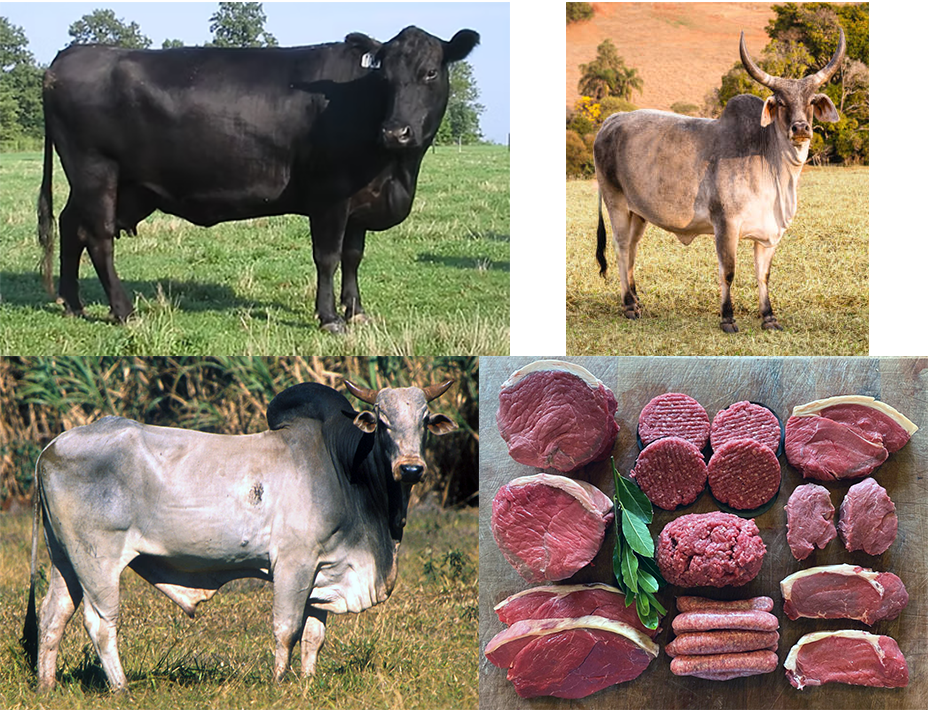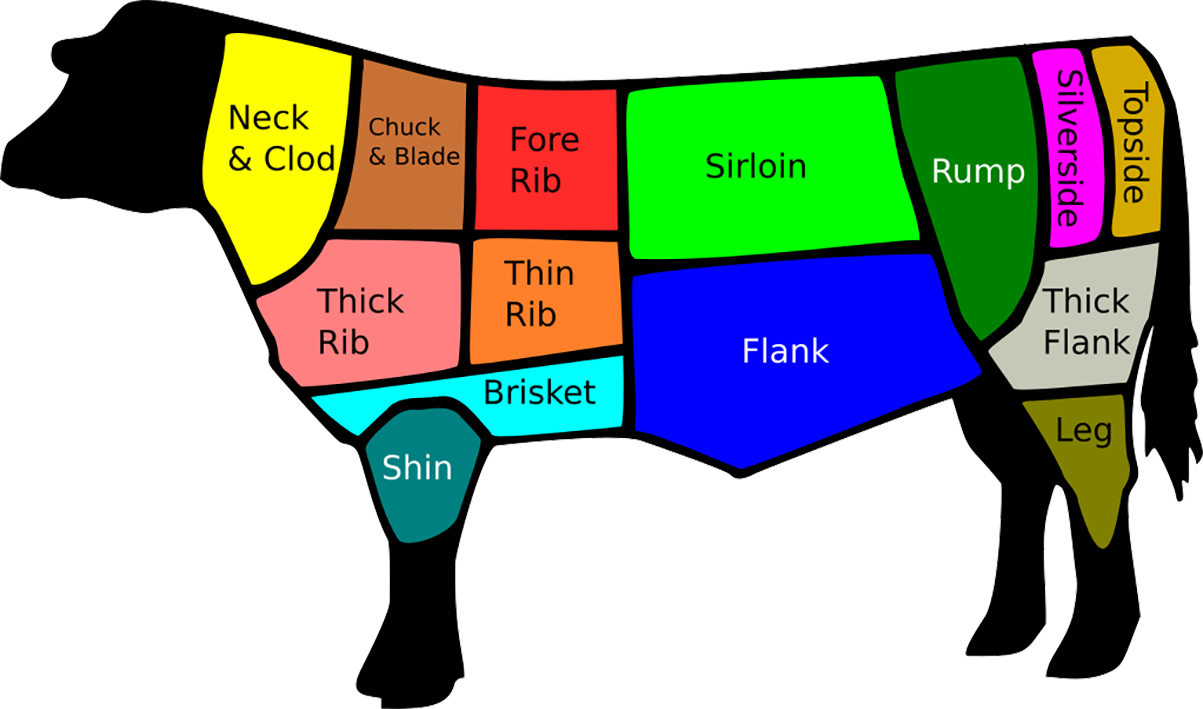FabulousFusionFood's Beef-based Recipes 4th Page
 Image of an European cow (top left), African Zebu (top right) and
Image of an European cow (top left), African Zebu (top right) andIndian bull (bottom left) along with a selection of beef cuts.
Welcome to FabulousFusionFood's Beef-based Recipes Page — The recipes presented here are all based on cow meat. Beef is the culinary name for meat from cattle (Bos taurus or Bos indicus). Beef can be prepared in various ways; cuts are often used for steak, which can be cooked to varying degrees of doneness, while trimmings are often ground or minced, as found in most hamburgers. Beef contains protein, iron, and vitamin B12. Along with other kinds of red meat, high consumption is associated with an increased risk of colorectal cancer and coronary heart disease, especially when processed. Beef has a high environmental impact, being a primary driver of deforestation with the highest greenhouse gas emissions of any agricultural product.
People have eaten the flesh of bovines since prehistoric times; some of the earliest known cave paintings, such as those of Lascaux, show aurochs in hunting scenes.[6] People domesticated cattle to provide ready access to beef, milk, and leather.[7] Cattle have been domesticated at least twice over the course of evolutionary history. The first domestication event occurred around 10,500 years ago with the evolution of Bos taurus. The second was more recent, around 7,000 years ago, with the evolution of Bos indicus in the Indian subcontinent. There is a possible third domestication event 8,500 years ago, with a potential third species Bos africanus arising in Africa.
Most beef can be used as is by merely cutting into certain parts, such as roasts, short ribs or steak (filet mignon, sirloin steak, rump steak, rib steak, rib eye steak, hanger steak, etc.), while other cuts are processed (corned beef or beef jerky). Trimmings, on the other hand, which are usually mixed with meat from older, leaner (therefore tougher) cattle, are ground, minced or used in sausages. The blood is used in some varieties called blood sausage. Other parts that are eaten include other muscles and offal, such as the oxtail, liver, tongue, tripe from the reticulum or rumen, glands (particularly the pancreas and thymus, referred to as sweetbread), the heart, the brain (although forbidden where there is a danger of bovine spongiform encephalopathy, BSE, commonly referred to as mad cow disease), the kidneys, and the tender testicles of the bull (known in the United States as calf fries, prairie oysters, or Rocky Mountain oysters). Some intestines are cooked and eaten as is,[64] but are more often cleaned and used as natural sausage casings. The bones are used for making beef stock. Meat from younger cows (calves) is called veal. Beef from steers and heifers is similar.
he word beef is from the Latin word bōs, in contrast to cow which is from Middle English cou (both words have the same Indo-European root *gʷou-). This is one example of the common English dichotomy between the words for animals (with largely Germanic origins) and their meat (with Romanic origins) that is also found in such English word-pairs as pig/pork, deer/venison, sheep/mutton, and chicken/poultry (also the less common goat/chevon). Beef is cognate with bovine through the Late Latin bovīnus.[4] The rarely used plural form of beef is beeves.
Cuts of Beef (British, Irish,Australian, South African and New Zealand terms):
 Cuts of Beef:
Cuts of Beef:Tongue — boiling, pickling, roasting or braising
Necks and clod — stewing, slow smoking or braising
Chuck steak & blades — mincing, braising, slow roasting
Sirloin — Frying, roasting, barbecuing
Rump — Frying, barbecuing
Silverside — Roasting
Topside — Roasting, pies, air drying
Top rump — Roasting, barbecuing
Fore rib — Roasting
Rib eye steak — Frying
T-bone steak — Frying
Thick rib — Braising, barbecuing, roasting
Thin rib — Braising, barbecuing
Brisket (Skirt steak) — Baking, boiling, roasting, braising
Shin and leg — Mince, slow stewing, braising
Flank — Barbecued, grilled, braised
Thick flank — Barbecued, grilled, braised
Feather blade — Frying, braising
Fillet — Frying, tartare
Oxtail — Stew, braising
Offal — typically liver, heart, stomach, intestines and kidneys
The alphabetical list of all the beef-based recipes on this site follows, (limited to 100 recipes per page). There are 697 recipes in total:
Page 4 of 7
| Irish Carbonnade Origin: Ireland | Khoodra Mafrooka Origin: Sudan | Madras-style Leftovers Curry Origin: India |
| Irish Kidney Soup Origin: Ireland | Kima (Chopped Beef and Chilli Fry) Origin: Senegal | Mafé Malienne (Malian Mafé) Origin: Mali |
| Irish Stock Origin: Ireland | Kipes or Quipes Origin: Dominican Republic | Maffe aux Legumes Arachide (Beef or Lamb in Peanut Butter) Origin: Senegal |
| Isicia Omentata (Roman Burgers) Origin: Roman | Kissra be Omregayga Origin: Sudan | Magatla (Oxtail Casserole) Origin: Botswana |
| Isicia Ova et Cerebella (Egg and Brain Sausages) Origin: Roman | Kitfo (Ethiopian Steak Tartar) Origin: Ethiopia | Malawian Biltong Origin: Malawi |
| Jamaican Beef Patties Origin: Jamaica | Kitfo Leb Leb (Fried Beef with Spices) Origin: Ethiopia | Mallow Stew Origin: Britain |
| Jamaican New Year Beef Patties Origin: Fusion | Kitoza Origin: Madagascar | Manos de Cerdo a la Peruana (Peruvian-style Pig's Trotters) Origin: Peru |
| Japanese Curry and Rice Origin: Japan | Koko na Nyama (Meat with Koko) Origin: Central African Republic | Manx Pasties Origin: Manx |
| Jarret de Boeuf Origin: Chad | Krain Krain (Jute Leaf Stew) Origin: Sierra Leone | Marrow Patties Origin: British |
| Jollof Rice with Chicken, Beef, and Ham Origin: Ghana | Krautstrudel (Cabbage Strudel) Origin: Liechtenstein | Maschi Origin: Sudan |
| Köttbullar med Saltgurka, Gräddsås och Äppelströssel (Meatballs with pickles, cream sauce and apple sprinkles) Origin: Sweden | Kuddelfleck (Tripe) Origin: Luxembourg | Massak'a (Egyptian Moussaka) Origin: Egypt |
| KöttfÄrs och olivpaj (Mince and Olive Pie) Origin: Sweden | Kulu'wa (Eritrean Chopped Meat) Origin: Eritrea | Massaman Beef Curry Origin: Thailand |
| Ka'abur (Beef and Potato Meatballs) Origin: Tunisia | Kurmanash Origin: India | Massaman Nuea (Beef Masaman Curry) Origin: Thailand |
| ka-re-raice (Korean Curry Rice) Origin: Korea | Laap (Beef Salad) Origin: Laos | Massaman Nuea (Beef Massaman Curry) Origin: Thailand |
| Kabab Kubideh (Grilled Minced Meat) Origin: Iran | Labadja Origin: Mali | Matura and Mahu Origin: Burundi |
| Kabritu Stoba (Stewed Kid Goat) Origin: Aruba | Lampara Curry Origin: Sri Lanka | Mayotte Brochettes de Boeuf Origin: Mayotte |
| Kalduni (Kalduni Dumplings) Origin: Lithuania | Lapskaus Origin: Norway | Meat and Potato Pasty Origin: England |
| Kalduny (Kalduny Dumplings) Origin: Siberia | Lasagne al Forno Origin: Italy | Meatball Brochettes Origin: Fusion |
| Kalia (Meat and Potato Curry) Origin: Bangladesh | Latvian Sorrel Soup Origin: Latvia | Meatballs in Garlic Broth Origin: Algeria |
| Kanda (Beef Meatballs with Pumpkin Seeds) Origin: Central African Republic | Leftover Roast Beef Jalfrezi Origin: Anglo-Indian | Meatballs on Sticks Origin: Britain |
| Kanda ti Nyma Origin: Central African Republic | Leftovers Stir-fry with Green Papaya Origin: American | Meatloaf with Indian Seasonings Origin: Fusion |
| Kangué (Ragout of Beef) Origin: Mayotte | Liver and Heart Kofta Curry Origin: India | Medium Stock Origin: Britain |
| Kansiyé Origin: Guinea | Liver Oxyrhynchus Origin: Roman | Methi Kalia (Spicy Fenugreek Meat) Origin: Bangladesh |
| Kansiyé avec 'Mafe' (Smoked Chicken in Peanut Sauce with Mashed Plantains) Origin: Guinea | Lobscows (Lobscouse) Origin: Welsh | Mexican Crockpot Chili Origin: American |
| Kare Kare Origin: Philippines | Lobscows #2 (Lobscouse) Origin: Welsh | Microwave Beef Spice Hotpot Origin: Britain |
| Katles (Spiced Beef and Potato Cakes) Origin: Madagascar | Lobsgows Gorllewin Affrica (West African Lobscouse) Origin: Welsh | Microwave Christmas Pudding Origin: Britain |
| Kebab Halla (Stewed Beef) Origin: Egypt | Lorn Sausage Origin: Scotland | Microwave Hamburger Origin: Britain |
| Kebab Koutbane Origin: Morocco | Loseyns (Lozenges) Origin: England | Microwave Jam Roly-poly Pudding Origin: Britain |
| Kebapcheta (Bulgarian Barbecue Sausage) Origin: Bulgaria | M'Chuzi wa Nyama (Tanzanian Curried Beef) Origin: Tanzania | Microwave Meatballs in Chilli Sauce Origin: American |
| Keema Aloo with Kale Origin: Scotland | M'Chuzi wa Nyama (Zanzibar-style Beef Curry) Origin: Britain | Microwave Spicy Mid-winter Pie Origin: Britain |
| Kefta dyal Ghriba (Synagogue Koftas) Origin: Tunisia | M'borokhé (Peanut Sauce with Spinach) Origin: Mali | Mince and Tatties Origin: Scotland |
| Kenyan Kima (Chopped Beef Chilli-fry) Origin: Kenya | Maafé Origin: Mali | Mince Curry with Peas Origin: South Africa |
| Kenyan Matoke Origin: British | Maafe (Meat Peanut Stew) Origin: Mali | |
| Kenyan Samosas Origin: Kenya | Machaca (Mexican Shredded Beef) Origin: Mexico |
Page 4 of 7